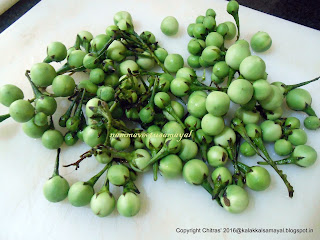#SundaikkaiMasalaCurry : It is called Devil's fig, Prickly nightshade, Turkish berry, Wild eggplant, pea eggplant in English. The scientific name is Solanum torvum.
#Sundaikkai tastes like brinjal but slightly bitter than that. It is commonly dried in the Sun to make vathal. The fried sundaikkai vathal is used in the preparation of vathakuzhambu and also to have with sambar rice.
The fresh ones are used in the preparation of sambar and curry. A special masala prepared using coconut with other condiments has been used to reduce the bitterness of the vegetable.
![Sundaikkai masala curry [ turkish berry curry ] Sundaikkai masala curry [ turkish berry curry ]](https://blogger.googleusercontent.com/img/b/R29vZ2xl/AVvXsEjQfNX1W8UpHTi2UC6jDTNdXyJOG4mKr2svpEkUSw4SG-j6jE4gSZCH7Do6LlPHXDR1XR7sVqkhVFIdobD7jNIfimJY5YcN0lqAby-nL6vXb1rXtCO1H7RFM0vzym6Jh4nvmYBrkQ59GSo/s640/1-DSCN1784.JPG)
A small quantity of coriander leaves to garnish.
Method :
Remove stem from sundaikkai and cut into halves.
Put in a bowl with water.
Grind all the ingredients except onion in a mixer without water.
Then add little water and make into a nice paste.
Now add cut onions and run the mixer for few seconds only.
Onion has to be ground in bits and pieces only, not into very smooth paste.
Keep aside.
Heat a kadai with 2 Tsp of oil on a stove over medium flame.
Crackle mustard seeds and then add black gram.
Once black gram becomes slightly golden color, add a pinch of turmeric powder .
Now add sliced onion and saute until it becomes translucent.
Then add chopped tomato and saute till it becomes soft.
Add halved sundaikkai and salt.
Saute for few minutes and then close with a lid.
Reduce the flame to SIM position and cook until sundakkai becomes soft.
It takes around five to seven minutes to cook the vegetables.
Once it is done add ground masala and mix well.
Adjust salt.
Keep stirring the curry at regular interval.
Transfer into a serving bowl when masala dries up and loses its raw smell.
This tasty and spicy sundaikkai masala curry goes well with white rice mixed either with sambar or rasam.
You might like to try
Curry Index
Ideas for Breakfast/Dinner
Varieties of Dishes for Lunch
Recipe Index
#Sundaikkai tastes like brinjal but slightly bitter than that. It is commonly dried in the Sun to make vathal. The fried sundaikkai vathal is used in the preparation of vathakuzhambu and also to have with sambar rice.
The fresh ones are used in the preparation of sambar and curry. A special masala prepared using coconut with other condiments has been used to reduce the bitterness of the vegetable.
![Sundaikkai masala curry [ turkish berry curry ] Sundaikkai masala curry [ turkish berry curry ]](https://blogger.googleusercontent.com/img/b/R29vZ2xl/AVvXsEjQfNX1W8UpHTi2UC6jDTNdXyJOG4mKr2svpEkUSw4SG-j6jE4gSZCH7Do6LlPHXDR1XR7sVqkhVFIdobD7jNIfimJY5YcN0lqAby-nL6vXb1rXtCO1H7RFM0vzym6Jh4nvmYBrkQ59GSo/s640/1-DSCN1784.JPG)
| Ingredients : | |
|---|---|
| 1 cup | Sundaikkai [ pea eggplant ] |
| 1 big size | Onion, slice into thin pieces |
| 1 medium size | Tomato, chop nicely |
| 2 Tsp | Oil |
| 1/2 Tsp | Mustard seeds |
| 1 Tsp | Black gram split [ urad dhal ] |
| A pinch | Turmeric powder |
| 1/2 Tsp | Salt [ adjust ] |
| For Masala : | |
| 2 Tbsp | Coconut scrapings |
| 1 Tsp | Cumin seeds |
| 1/2 Tsp | Fennel seeds |
| 1 Tsp | Coriander powder |
| 2 cloves | Garlic |
| 1 or 2 | Red chilly [ adjust ] |
| 1 medium size | Onion diced |
| 10 | Curry leaves |
| 2 Tsp | Coriander leaves chopped |
| 1/4 Tsp | Salt |
Method :
Remove stem from sundaikkai and cut into halves.
Put in a bowl with water.
Grind all the ingredients except onion in a mixer without water.
Then add little water and make into a nice paste.
Now add cut onions and run the mixer for few seconds only.
Onion has to be ground in bits and pieces only, not into very smooth paste.
Keep aside.
Heat a kadai with 2 Tsp of oil on a stove over medium flame.
Crackle mustard seeds and then add black gram.
Once black gram becomes slightly golden color, add a pinch of turmeric powder .
Now add sliced onion and saute until it becomes translucent.
Then add chopped tomato and saute till it becomes soft.
Add halved sundaikkai and salt.
Saute for few minutes and then close with a lid.
Reduce the flame to SIM position and cook until sundakkai becomes soft.
It takes around five to seven minutes to cook the vegetables.
Once it is done add ground masala and mix well.
Adjust salt.
Keep stirring the curry at regular interval.
Transfer into a serving bowl when masala dries up and loses its raw smell.
This tasty and spicy sundaikkai masala curry goes well with white rice mixed either with sambar or rasam.
 |
 |
 |
 |
 |
 |
 |
 |
You might like to try
|
|
|
||||||
|
|
Curry Index
Ideas for Breakfast/Dinner
Varieties of Dishes for Lunch
Recipe Index
![ennai katharikkai [ brinjal masala curry] ennai katharikkai [ brinjal masala curry]](https://blogger.googleusercontent.com/img/b/R29vZ2xl/AVvXsEhTNkHxXQ29DT-xzp88jxUuL2mMAhyvFZYBhb3LhZnxkDpQVBkQ8jAfEx741pOsxm5ByWi_9A_Stbd-HPG2EUQNOYAk9KTB6H7ZauPyvd8OxLQ8buzBa-_cleniiLgWVEfdK4gHaiGn21s/s640/1-DSCN9401.JPG)
![katharikkai [ brinjal ] phata phat curry katharikkai [ brinjal ] phata phat curry](https://blogger.googleusercontent.com/img/b/R29vZ2xl/AVvXsEijFkY6YAdODzCs_xSsxX-wk39P4J9xaFjk0NXOWr-sE2Nxki8ipICfs5UISTaKTUfvhs2S5yFF6qmVWV2PKNJzG0JC6y_FcyeiiplBIjyrlHSuRsqpuB-0aiJaS-jOkAYjVbmgSQiNiF3g/s1600/1-DSCN3031.JPG)
![kothavarangai [ cluster beans ] paruppu usili kothavarangai [ cluster beans ] paruppu usili](https://blogger.googleusercontent.com/img/b/R29vZ2xl/AVvXsEgOb9nzz2azZZGMGy89-_EFWcO_buEFQQEsv8IyKPwdSI_wiHYCJtqW_J-YI8V1tdvmv_qEqa59LjnHDrMTt73Qa0aFXNKYO67_Jr-2ib9a0C8ZzmFe-EBJZMyBbcHS1evhIfB7Ek_VNbY/s1600/1-DSCN7045.JPG)
![pagarkkai [ bitter gourd ] paruppu masala curry pagarkkai [ bitter gourd ] paruppu masala curry](https://blogger.googleusercontent.com/img/b/R29vZ2xl/AVvXsEgVY25H139iBDWFaBS48jDTQeY5hV0PFTVxcQruz2dncXCIHCsEYmoj6xUO5vu-kT_CDBG9P88GV3fbJY1Ywjwqqo5uBRmoQY_TEviR08EbuqJSYMfbH-_WJspjn1y90j4-xQOmoNakFcs/s320/1-DSCN1516.JPG)

No comments:
Post a Comment